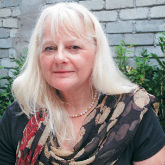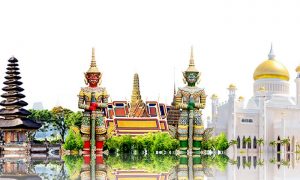Frances Wilks visited Medan recently and discovered some of the historical similarities and links between the capital of North Sumatra and the Pearl of the Orient.
One of the joys of living in Penang is the realisation that nowhere in Southeast Asia is very far away, so there are many potential choices for a short break or long weekend. Medan, a mere hour’s hop across the water in Indonesia, sometimes called the Penang of Sumatra, could be an excellent choice. Although Medan is usually seen as place of passage on the way to Sumatra’s landscape treasures, the interior mountains and the scenic Lake Toba, it really should be thought of as a destination in its own right. On arrival at Polonia Airport in Medan, you find yourself an instant millionaire but since a cup of coffee costs you 20,000 rupiah, you sadly realise that you will quickly work your way through your fortune! It’s also advisable to take US$25 with you in cash to pay the visa-on-arrival fee to Indonesia, as, if you attempt to pay in any other currency, you will find that you receive an extremely unfavourable rate of exchange.You also have to remember to keep 75,000 rupiah for your departure tax when leaving Indonesia. Despite this rather off-putting and unwelcoming bureaucracy, the people of Medan are friendly and laid-back, often taking time and effort to help a stranded tourist to their destination. Hotel choice is very wide from backpackers’ hostels to plush five-star establishments and there are lots of cafes and restaurants to tempt the hungry traveller.
Like Penang, Medan grew from humble village beginnings, only really taking off in the nineteenth century when the Dutch colonists of the time established tobacco plantations in the surrounding area. Medan became a trading place for tobacco and other crops and because the new plantations required manpower, there was an infl ux of Chinese labour from South China, much as there was in Penang.These new immigrants needed to be organised and an energetic young Chinese entrepreneur,Tjong a Fie, was just the man to take on such a task. Interestingly, he was the nephew of a famous Penang Chinese merchant, Cheong Fatt Tze, who built the Blue Mansion in George Town, now a boutique hotel.
Born in 1860, in Guandong province, Tjong a Fie came to Medan at the age of 17 and quickly established himself as a trusted friend and loyal servant of the local Sultan of Deli.This opened doors and, before long, Tjong a Fie was bringing skilled labour in from both Penang and China as well as running plantations. In his middle age, he branched out into the banking sector, and also into road and house construction and was made the China Kapitan, or head of the Chinese Community. He also built a fi ne house, which echoes his uncle’s Blue Mansion but on a rather smaller scale, known as the Tjong a Fie Mansion. By the time Tjong a Fie died in 1921, he was so well-known that most of Medan came to his funeral.
His last surviving grandson, Jan Tjong looks after the mansion, which is now open to the public, with his sister, Mimi. “I am proud of my grandfather’s achievements. He was a broad-minded man, who created links between people and groups and thus became very successful. Although the house he built is a national treasure, it still hasn’t got heritage status, which is my hope and dream to achieve.”
The mansion itself is set in a tranquil garden off the bustling Kesawan Square in the centre of Medan, opposite the famous old Tip Top Café, with its many Dutch and Indonesian treats. Like Penang’s Blue Mansion it is designed around several courtyards which create light and air. Constructed in 1900, it is in the Asian Art Deco Style with many Peranakan features, such as the red and gold carved wooden screen which separates the public part of the house from the more private space. It also has two ancestral altars, a reminder of the family’s deep roots in China.There are hand-painted ceilings upon which birds and flowers weave enchanting patterns as well as imported floor tiles from a Venetian palace.There are many photographs from Tjong a Fie’s adventurous life (he was married three times, and his last wife came from Ayer Itam in Penang) as well as artefacts and furniture of the period.
Although Medan and Penang have historical connections, they don’t look at all alike. Medan is much more sprawling than Penang where space is limited.The streets are broader than those of George Town and the local transport, a motorbike with sidecar attachment for the fare to sit in, ply their noisy trade.They are fast – if a little nerve-wracking – and amusingly covered in recycled plastic advertisement banners and so you may find yourself being propelled along the street advertising the local whisky! In a way Medan’s slightly neglected buildings with their crumbling plaster and peeling paint (in sharp contrast to the glossily restored shophouses in George Town) are very reminiscent of townscapes in Sri Lanka. Upon reflection, despite the historical links between the two cities, Medan is perhaps more the Colombo than the Penang of Sumatra.
———————————————————————————————————
Source: Penang International April 2013 – May 2013
Read more:
- Top Two Beach Resorts on Rawa Island
- The Allures of Going on a Kuala Lumpur – Royal Belum State Park Road Trip
- Great Ideas for Road Trips in Malaysia
What are your thoughts on this article? Let us know by commenting below.No registration needed.
"ExpatGo welcomes and encourages comments, input, and divergent opinions. However, we kindly request that you use suitable language in your comments, and refrain from any sort of personal attack, hate speech, or disparaging rhetoric. Comments not in line with this are subject to removal from the site. "

















